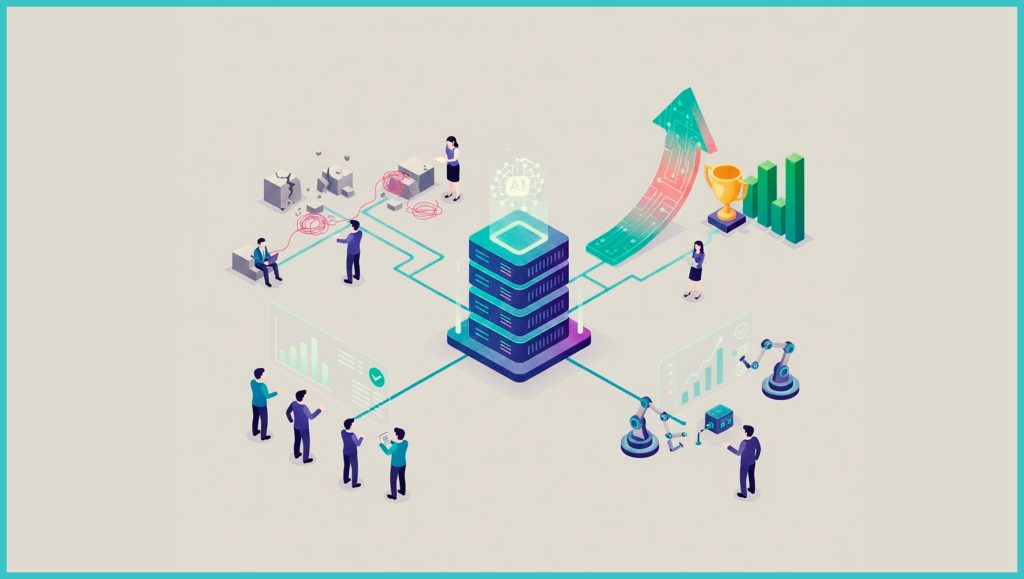Are you faced with the decision of choosing between a product-led or customer-led growth strategy for your company? Rest assured, whichever strategy you opt for, it will have a profound impact on your customer retention, conversion rates, and overall customer engagement. The chosen strategy will serve as the driving force behind your company’s growth and the ultimate success of your company. With careful consideration and strategic planning you can move towards sustainable growth.
In the fiercely competitive business environment of today, businesses are always looking for novel approaches to achieve long-term success. The use of product-led growth (PLG) models is one method that has gotten a lot of traction lately. In contrast to conventional sales- and marketing-driven strategies, PLG prioritizes the product, using its value to promote client acquisition, retention, and growth.
Understanding Product-Led Growth Models
PLG models are go-to-market strategies that place a premium on the product as the main engine of customer growth and revenue expansion. PLG models place a greater emphasis on offering an amazing user experience and producing a product that is so valuable and simple that it automatically attracts and maintains customers, in contrast to conventional sales and marketing strategies. These business strategies frequently entail providing a free or freemium version of the product so that users can evaluate its essential features before deciding to subscribe to a paid plan.
PLG models prioritizes improving the customer experience, maximizing network effects and viral growth, and promoting effective client acquisition. By examining user behavior and feedback, they also emphasize data-driven iteration and continual development. PLG models encourage improved customer retention rates and expansion potential by placing a stronger priority on client centricity and user pleasure.
Benefits of Product-Led Growth Models
Some benefits of product led growth models are listed below:
1. Enhanced Customer Experience
A key advantage of Product-Led Growth (PLG) models is the focus on providing an outstanding customer experience. PLG businesses engage in developing user-friendly interfaces, smooth onboarding procedures, and enjoyable user interactions by putting the product first. Increased consumer loyalty and brand advocacy result from the emphasis on user happiness, which fosters a favorable emotional connection with the product and the brand.
Additionally, PLG models give users the chance to directly feel the product’s essential value, which enables them to completely comprehend its advantages and possibilities. With this strategy, the company and its customers can develop a solid and enduring relationship that increases trust and faith in the product.
2. Viral Growth and Network Effects
The potential for network effects and viral growth is one of the major advantages of product-led growth (PLG) models. Customers are more inclined to recommend products to their networks when they are created to provide excellent value and a unique user experience. This natural word-of-mouth advertising may have a viral impact, quickly gaining popularity and drawing in new users.
In addition, network effects are frequently included in PLG goods, meaning that the value of the product rises as more people join the platform. The benefits of the product are amplified as the user base grows, thanks to the network effect, making it more enticing to both current and new customers. This positive feedback loop of viral growth and network effects quickens customer acquisition, fuels exponential expansion, and reinforces the business as a whole.
3. Efficient Customer Acquisition
Product-Led Growth (PLG) models’ capacity to promote effective customer acquisition is one of its key advantages. PLG uses free or inexpensive entry points, such as free trials, free tiers, or freemium plans, to draw in a large user base. Companies can cast a wide net and draw in a sizable audience by providing a taste of the value of the product.
This strategy minimizes the costs associated with acquiring new customers while also lowering entry barriers. Users are more inclined to switch to paid plans or become advocates after experiencing the product’s advantages firsthand, which will naturally spread the word and bring in new clients.
Companies may swiftly expand their user base, achieve sustainable growth, and more effectively devote resources to product development and customer success thanks to this streamlined customer acquisition process.
4. Data-Driven Iteration and Continuous Improvement
Continuous improvement and data-driven iteration are key components of product-led growth models. Businesses can get important insights about how their product is used, which features are most valuable, and where changes can be made by utilizing robust analytics and user behavior data. This data-driven strategy enables companies to prioritises development efforts, make wise decisions, and improve user experience.
Companies may pinpoint pain areas, enhance user onboarding, and simplify the functionality of their products by carefully monitoring important KPIs and user input. This iterative process makes sure that the product stays valuable, current, and in line with consumer needs, which boosts user engagement and happiness. Companies can stay ahead of the competition, adjust to market expectations, and provide an amazing user experience that fuels sustained growth when they can iteratively develop the product based on data insights.
5. Customer-Centricity and User Feedback
The emphasis on customer-centricity and user feedback in product-led growth models is one of their key advantages. PLG businesses constantly seek user feedback and maintain open dialogue with their clients to learn about their requirements, preferences, and problem areas. By having a direct line of communication, companies can better understand their target market and tailor their product offers to suit.
Companies may iteratively improve products, address customer pain points, and improve the user experience by incorporating user feedback into the product development process. In addition to fostering stronger customer relationships, this customer-centered strategy makes sure that the product remains valued and relevant, which eventually leads to greater customer happiness, loyalty, and long-term commercial success.
6. Increased Customer Retention and Expansion
The capacity of Product-Led Growth models to improve customer retention and spur expansion potential is one of its key advantages. Companies may build a loyal customer base that is engaged and satisfied over time by providing a superior product experience. PLG models ensure that the product remains valuable and relevant through ongoing product modifications and upgrades based on user feedback, thus strengthening client loyalty.
Additionally, PLG models encourage growth by providing upsells, cross-sells, and higher-tier plans to current clients who have already benefited from the product’s fundamental benefits. Businesses may increase the lifetime value of each client, spurring revenue growth and building a sustainable business model, by putting a strong emphasis on customer success and continuing involvement.
Read More: SalesTechStar Interview with Anthony Soohoo, Member of the Board of Directors, Spryker
Strategies for driving product led growth:
Focusing on the product itself and utilizing its value to draw in and keep customers are key components of strategies for fostering product-led growth. Here are some crucial tactics to take into account:
- Provide Free Trials or Freemium Plans: By offering free trials or freemium plans, you may provide potential customers the chance to evaluate the worth of your product. This enables people to investigate its features and advantages before choosing to buy.
- Streamline the onboarding procedure: Streamlining the onboarding process helps to make sure that new users can immediately comprehend and begin using your product. Give consumers information, tutorials, and directions that are clear to ensure a good user experience.
- Use programs that encourage referrals and viral loops: Offer incentives or rewards to your current consumers who recommend your product to their friends and coworkers. Utilize viral loops to promote your product through word-of-mouth and foster organic growth.
- Maintain a focus on user adoption and engagement metrics: This helps to learn more about how people are interacting with your product. Locate trouble spots or locations where consumers may be losing interest, then make changes to boost usage and satisfaction.
- Implement a product led culture: Create a Company Culture that Values and Prioritizes the Product Experience by Promoting a Product-Led Culture. Encourage cross-functional cooperation and provide teams the freedom they need to make changes to products and ensure customer success.
- Offering excellent customer service: Offering excellent service to customers means being quick to respond and accommodating to any queries or problems people may run across. Customer loyalty is increased and the whole product experience is improved with prompt and efficient service.
By putting these tactics into practice, you can promote user adoption, create a superior product experience, and use customer happiness to fuel both organic growth and customer acquisition to generate product-led growth.
Understanding Customer-Led Growth Models
A strategic business technique called “customer-centric growth” (CCG) uses the power of your customers to propel exponential revenue growth. Putting your customers first enables you to access a useful and dependable resource. This methodology places a strong emphasis on the significance of comprehending and satisfying customer wants, which will ultimately lead to an increase in customer loyalty and satisfaction and business development.
By utilizing your customer base’s insights, recommendations, and feedback, you can quickly and affordably expand your income base with CCG. So, in short a CLG model is a strategic approach that focuses on the customer, helps to collect customer insights and improves their experience.
Customers are essential to generating revenue growth, and by putting a strong emphasis on a customer-centric go-to-market strategy, businesses may expand effectively and sustainably through important channels including advocacy, retention, and expansion. Businesses should lessen their dependence on gaining new consumers and instead promote organic growth by cultivating current customer relationships and offering outstanding value.
Customers that are happy with the service become brand ambassadors, generating new business through recommendations and positive word-of-mouth. Additionally, by concentrating on client retention, businesses can create long-lasting relationships, increase customer lifetime value, and lower churn. This tactical move towards a customer-centric mindset not only boosts sales but also lays the groundwork for long-term success and market supremacy.
Benefits of customer led strategy:
The benefits are many of the customer led growth models and they can have a significant impact on the success and sustainability of a business. So, here are some key advantages.
1. Improved customer experience
Since the customer is at the core of the growth plan, the needs and pain issues of the customers are genuinely given precedence. This enables you to resolve client complaints and enhance your products and services in order to provide top-notch customer service. A good customer experience helps to increase brand loyalty, motivates repeat business, and draws in new clients via favorable word of mouth.
2. Improved development of products
You can learn a lot about how to improve the products or services you sell by aggressively seeking out consumer input and properly adopting it. By using a customer-driven approach to product creation, you can be sure that the solutions you provide will be in line with their needs and preferences. You may boost the likelihood of product market success and long-term success by consistently improving and iterating your offers based on feedback from clients.
3. Increased Brand Loyalty and Advocacy
Customers who feel heard and respected are more likely to become brand advocates. Because they are more likely to stay interested and do business with you in the long run, this encourages loyalty. Additionally, happy consumers turn into promoters who readily tell others about your goods or services, resulting in organic development through recommendations and favorable evaluations.
4. Higher Customer Retention Rates
You may enhance customer retention rates by putting the needs of your customers first and working hard to address those requirements as they change. Customers who are satisfied are less prone to churn and switch to rival brands. As maintaining current customers is frequently more cost-effective than obtaining new ones, this results in enhanced customer lifetime value and decreased client acquisition expenses.
5. Sustainable growth
Building a solid foundation for sustainable and scalable growth requires connecting your growth plan with client demands and preferences. merely depending exclusively on recruiting new customers, customer-led growth places an emphasis on developing long-term connections and optimizing client value. With this strategy, your business is set up for long-term success, steady revenue streams, and increased profitability.
Strategies for customer led growth model:
Placing customers at the center of your business and giving priority to their wants and experiences are strategies for fostering a customer-led growth strategy. Here are some important tactics to think about:
- Acquire Customer input and Take Action On It: Regularly acquire customer input through surveys, interviews, or feedback forms. Utilize this feedback to learn about their concerns, preferences, and ideas for change. Include client input proactively in product development and corporate strategy.
- Foster Strong Customer ties: By offering individualized experiences and top-notch customer service, you may cultivate strong ties with your customers. Engage with them using a variety of platforms, including social media, email, and community forums, and swiftly address any questions or issues they may have.
- Implement customer success programs: Create customer success initiatives that are focused on assisting consumers in achieving their intended results from using your product or service. To make sure that they are getting the most out of your product, give them tools, training, and ongoing assistance.
- Encourage Customer Advocacy: Find and cultivate brand evangelists. Encourage pleased customers to provide testimonials, case studies, or recommendations to share their positive experiences. Utilize their support to draw in new clients and establish your brand’s credibility.
- Segment your consumer base: Segment your customer base and personalize your communications and interactions to reflect each group’s special needs and preferences. To improve the user experience, provide individualized recommendations, targeted marketing initiatives, and pertinent content.
- Promote a customer-focused culture: By instilling this mentality across your entire company. Make sure that the customer’s demands are understood and given top priority by every team, from product development to sales and customer service. Make internal decisions and align your operations with the objective of providing excellent client experiences.
- Develop customer success initiatives: Such initiatives that are focused on helping customers achieve the results they had in mind when they chose to utilize your product or service. Give them tools, training, and continuous support to ensure that they are making the most of your product.
By placing these tactics into execution, you can foster customer-led growth by continually providing value to your clients, cultivating solid bonds with them, and utilizing client advocacy and satisfaction to drive company growth and development.
Product led growth models vs customer led growth models: Which one should you consider?
Both customer-led growth and product-led growth are crucial business success methods, and they don’t conflict with one another. In fact, they may support one another and cooperate to promote global advancement. Let’s examine their role in boosting client retention and scaling consumer acquisition.
The Product-led Growth (PLG) method is centered on developing a product or service which helps customers and promotes expansion. Free trials, freemium plans, or self-serve options are frequently provided by PLG enterprises so that customers can personally experience the advantages of the product. PLG strategies seek to attract and convert more customers by highlighting the product’s utility and usability. This initial product-led strategy establishes the groundwork for attracting consumers who will later be able to offer insightful input for customer-led growth.
The core of the customer-led growth approach is acquiring the customer insights and feedback in order to enhance the good or service. Businesses can focus their improvements and optimization by listening to customers and comprehending their problems. This customer-centric strategy shows a dedication to satisfying client needs and providing an outstanding experience. Customers become more involved and committed as they see their suggestions being implemented into the product, which helps with advocacy and client retention.
Read More: SalesOps and MarketingOps Tips for B2B Team
Which One Should You consider?
It’s crucial to understand that product-led growth and customer-led growth are intertwined and ought to cooperate. So, both the strategies are ideal for your business.
Initial customer acquisition and boarding can be helped by a focus on product-led growth, allowing you to get preliminary feedback. You could use this user input as your user base grows to inform product updates that promote product-led growth. You may develop a positive feedback loop that promotes customer pleasure, loyalty, and long-term growth by iterating and improving the product regularly based on user insights.
It’s critical to take your company’s unique circumstances and objectives into account when choosing between a customer-led growth model and a product-led growth model. Here are some things to take into account when choosing:
- Customer-Centric Approach: If your business places a high priority on knowing and satisfying the demands of its clients, a customer-led growth model can be the best option. To advance product innovations and overall growth, this strategy places a premium on acquiring customer insights, feedback, and relationships.
- Product Differentiation: A product-led growth plan may be suitable if your good or service has unique characteristics or a compelling value proposition. This business strategy emphasizes on providing a fantastic user experience for the product, which encourages viral adoption, word-of-mouth recommendations, and increasing client acquisition.
- Market Dynamics: Evaluate your industry’s competitive environment and market dynamics. A customer-led growth model can help differentiate your brand through excellent customer experiences and solid relationships if there is fierce competition and customer loyalty is essential.
- Resources and Capabilities: Assess the resources, capacities, and knowledge of your firm. Strong emphasis on consumer research, feedback systems, and the capacity to swiftly make product enhancements based on customer insights are requirements for a customer-led growth model. The foundation of a product-led growth strategy is the improvement of self-serve channels and the development of outstanding products.
- Business Stage: Take into account the stage of your company. A product-led growth strategy might assist in bringing in and converting new clients if your business is in its early stages and has a small user base. To retain and grow your client base, you can move toward a customer-led growth strategy as you develop and acquire more consumer insights.
Using these models in a systematic way can help your business immensely because the success of an organization depends on both product- and customer-driven growth. While customer-led growth makes use of consumer data to improve the product and improve the customer experience, product-led growth focuses on attracting new customers. Businesses may expedite client acquisition, improve customer retention, and achieve sustainable growth by combining the advantages of both approaches.
Let’s look at the key differences between both the strategies in brief to get a clear understanding:
Customer-led growth strategy:
- Places a strong emphasis on using user insights to improve the customer experience.
- Focuses on gathering customer feedback and using it to improve products.
- Uses strategies including smooth signup flows, onboarding checklists, and in-app instructions.
- Enables customers to succeed by offering self-service choices like video tutorials and support documents.
- Gather client information for personalization and segmentation.
- Analyzes user behavior and product usage data to spot friction areas.
- Uses in-app micro surveys and a Voice of the user program to collect user feedback.
- By being open about product changes impacted by user feedback, closes the customer feedback loop.
- Uses a customer-facing roadmap for communicating plans and responding to the needs of customers.
Product-led growth strategy:
- Emphasizes that the key factor in revenue growth is the customer experience with the product.
- Makes an effort to provide an excellent product that attracts and retains customers.
- Uses tactics like a free trial with time-limited premium features, smooth signup processes, and onboarding demo content.
- Emphasizes the role that the Zeigarnik Effect and activation energy play in generating user engagement.
- Uses in-app help to support and educate current users.
- Through self-service alternatives and individualized experiences, prioritizes customer success.
- Analyzes user behavior and product usage data to spot areas for improvement.
- Feedback is gathered through in-app surveys, and NPS survey results are tagged for analysis.
- Shares product plans through a customer-facing roadmap, to communicate product plans, putting more emphasis on meeting customer demands than on including new features.
Conclusion
Product-Led Growth models have emerged as a powerful and effective strategy for driving customer acquisition, retention, and revenue growth. By prioritizing the product itself and ensuring an exceptional user experience, companies can harness the benefits of viral growth, efficient customer acquisition, data-driven iteration, and customer-centricity. PLG models empower businesses to build strong customer relationships, adapt to evolving market needs, and sustain long-term success in an increasingly competitive landscape.
On the other hand customer led growth models lay emphasis on customer insights to guide growth that helps in delivering amazing customer experience and scale up brand advocates. Increasing revenue from current consumers at greater margins as opposed to attracting new customers is one strategy for accelerating profitability using a customer led growth model. Businesses can improve growth efficiency by lowering post-sale costs by prioritizing client revenue growth and implementing proactive retention and growth tactics.
Building brand and customer advocates aids in extending the brand’s reach and accelerating growth, while actively pursuing customer expansion permits tapping into new revenue streams. To ensure long-term customer happiness and financial stability, maximizing retention also entails reducing churn risk and optimizing renewal amounts.
So, both the growth models offer several advantages and combining the two methods can be wiser, so you can reap the benefits of both to promote growth. It’s critical to continuously assess your approach in light of feedback from customers, industry changes, and corporate objectives. The decision between customer-led growth and product-led growth ultimately comes down to your own business goals and circumstances.
***The Primary Author of this piece is Staff Writer, Sakshi John





















